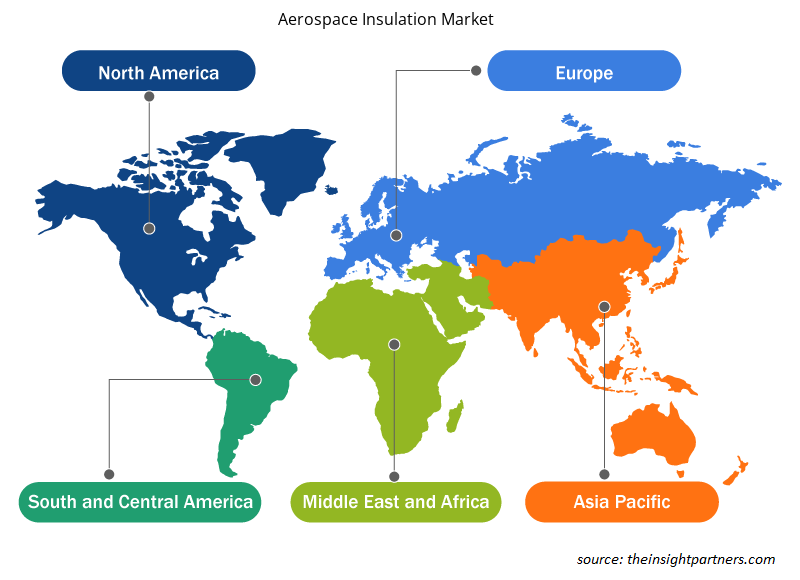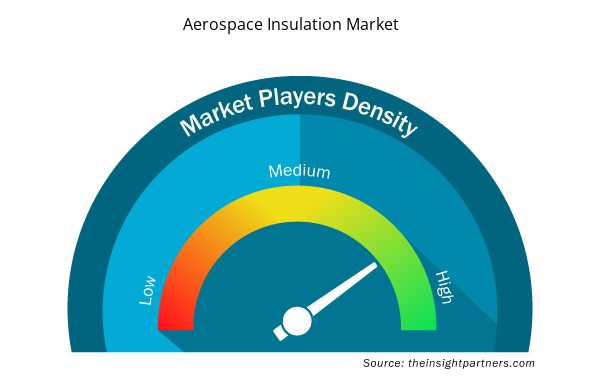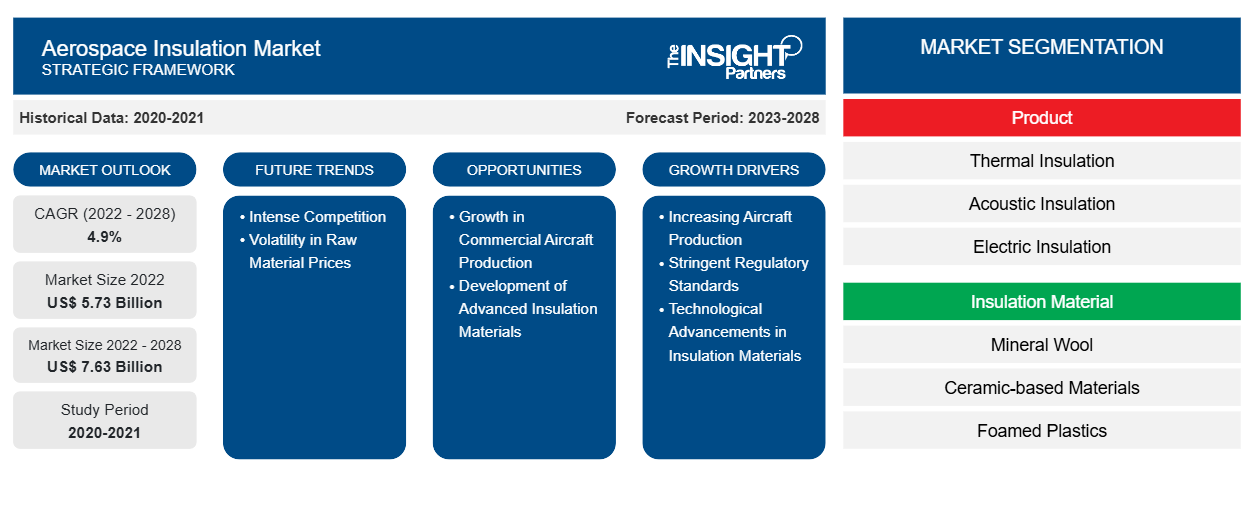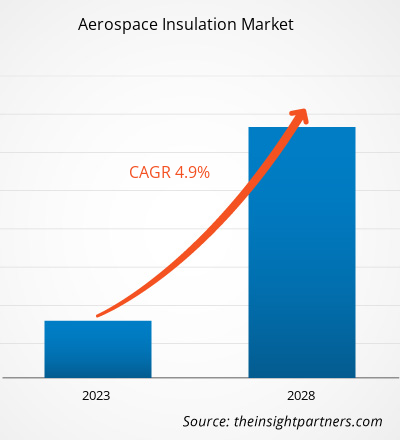Se espera que el mercado de aislamiento aeroespacial crezca de US$ 5.731,28 millones en 2022 a US$ 7.633,23 millones en 2028; se estima que crecerá a una CAGR del 4,9% entre 2022 y 2028.
El aislamiento aeroespacial se refiere al material instalado en la aeronave para mejorar los niveles de seguridad y comodidad. Las funciones de la aeronave en condiciones climáticas severas deben cumplir con ciertas operaciones fundamentales, así como con las medidas de seguridad relacionadas con el peso y la temperatura y el rendimiento general. Debido a las ventajas, como los niveles más bajos de vibración y ruido durante las horas de vuelo, la demanda de materiales aislantes está creciendo a un ritmo rápido. Se espera que el uso creciente de materiales compuestos en aeronaves comerciales impulse el desarrollo de diversas aeroestructuras , lo que dará como resultado un potencial industrial sustancial. Es probable que la creciente demanda de materiales aislantes livianos y materiales compuestos en las industrias de aeronaves comerciales y jets ejecutivos para reducir el ruido de la cabina impulse el mercado en los próximos años.
El aislamiento aeroespacial desempeña un papel crucial en la protección de la tripulación y los pasajeros del ruido de los generadores y las temperaturas gélidas a mayores altitudes. Se espera que la creciente demanda de flotas ligeras, aeronaves de nueva generación y de bajo consumo de combustible, junto con la creciente importancia de la reducción de las emisiones, aumente la producción de aeronaves. El importante desarrollo de la industria de los viajes en los mercados emergentes y el creciente número de pasajeros en viajes internacionales y nacionales son los principales factores que impulsan el mercado mundial del aislamiento aeroespacial . Por ejemplo, según la Asociación Internacional de Transporte Aéreo ( IATA ), la demanda total de viajes aéreos en abril de 2022 aumentó un 78,7% en comparación con abril de 2021.
Personalice este informe según sus necesidades
Obtendrá personalización en cualquier informe, sin cargo, incluidas partes de este informe o análisis a nivel de país, paquete de datos de Excel, así como también grandes ofertas y descuentos para empresas emergentes y universidades.
- Obtenga las principales tendencias clave del mercado de este informe.Esta muestra GRATUITA incluirá análisis de datos, desde tendencias del mercado hasta estimaciones y pronósticos.
Según la Administración Federal de Aviación (FAA), todos los aviones comerciales deben contar con aislamiento térmico y acústico. Estos aislantes garantizan que el confort de los pasajeros no se vea afectado por las variaciones de temperatura exterior y que el ruido excesivo que genera el avión no interfiera en la comunicación. Estas estrictas regulaciones animan a los fabricantes de aviones a utilizar material aislante en sus aeronaves, lo que impulsa el mercado de aislamientos aeroespaciales.
Muchos fabricantes de aislamientos aeroespaciales, como Zotefoams, están desarrollando materiales de construcción aeroespaciales livianos para aumentar la eficiencia del combustible y la sostenibilidad. El aislamiento térmico y acústico protege contra el ruido y la temperatura excesivos en la mayoría de las aeronaves. El aislamiento térmico y acústico es una fibra única de alto rendimiento envuelta en una cubierta de plástico apta para aeronaves que mantiene unidos los materiales aislantes y, al mismo tiempo, funciona como barrera contra la humedad.
Perspectivas del mercado
El crecimiento del sector del transporte aéreo impulsa el mercado del aislamiento aeroespacial
El sector del transporte aéreo se está expandiendo rápidamente y se espera que continúe así durante los próximos años. Según la estimación de la Asociación Internacional de Transporte Aéreo ( IATA ), se espera que la demanda de transporte aéreo aumente en un promedio del 4,3% anual hasta 2036. Si este crecimiento se logra para 2036, se espera que la industria del transporte aéreo contribuya con 15,5 millones de empleos directos y 1,5 billones de dólares de PIB a la economía mundial durante el período de pronóstico. Un crecimiento tan significativo en la demanda de transporte aéreo conducirá a una mayor demanda de aeronaves. El aislamiento aeroespacial se utiliza en las aeronaves para aumentar la comodidad y la seguridad de las aeronaves y los viajeros, lo que se espera que impulse el mercado del aislamiento aeroespacial durante el período de pronóstico. Además, el costo de los materiales compuestos está disminuyendo continuamente, lo que permite a los fabricantes de aeronaves utilizar compuestos para el aislamiento aeroespacial. Por lo tanto, debido a estos factores, el mercado florecerá rápidamente durante el período de pronóstico.
Información sobre el producto
Según el producto, el mercado de aislamiento aeroespacial se segmenta en aislamiento térmico, aislamiento acústico, aislamiento eléctrico y aislamiento de vibraciones. En 2021, el segmento de aislamiento térmico dominó el mercado y se espera que crezca a una CAGR más rápida durante el período de pronóstico. El aumento de las actividades de investigación y desarrollo para producir material de aislamiento térmico avanzado, liviano y sostenible está impulsando el crecimiento del segmento de aislamiento térmico durante el período de pronóstico.
3M; TransDigm Group Incorporated; Triumph Group, Inc.; Johns Manville ; Morgan Advanced Materials Plc ; Polymer Technologies Inc.; Duracote Corporation; Rogers Corporation; DuPont; y BASF SE son los actores clave que operan en el mercado de aislamiento aeroespacial. Los actores líderes adoptan varias estrategias, como fusiones y adquisiciones y lanzamientos de productos, para expandir su presencia geográfica y su base de consumidores.
Perspectivas regionales del mercado de aislamiento aeroespacial
Los analistas de Insight Partners explicaron en detalle las tendencias y los factores regionales que influyen en el mercado de aislamiento aeroespacial durante el período de pronóstico. Esta sección también analiza los segmentos y la geografía del mercado de aislamiento aeroespacial en América del Norte, Europa, Asia Pacífico, Oriente Medio y África, y América del Sur y Central.

- Obtenga datos regionales específicos para el mercado de aislamiento aeroespacial
Alcance del informe sobre el mercado de aislamiento aeroespacial
| Atributo del informe | Detalles |
|---|---|
| Tamaño del mercado en 2022 | 5.730 millones de dólares estadounidenses |
| Tamaño del mercado en 2028 | US$ 7.63 mil millones |
| CAGR global (2022-2028) | 4,9% |
| Datos históricos | 2020-2021 |
| Período de pronóstico | 2023-2028 |
| Segmentos cubiertos | Por producto
|
| Regiones y países cubiertos | América del norte
|
| Líderes del mercado y perfiles de empresas clave |
|
Densidad de actores del mercado de aislamiento aeroespacial: comprensión de su impacto en la dinámica empresarial
El mercado de aislamiento aeroespacial está creciendo rápidamente, impulsado por la creciente demanda de los usuarios finales debido a factores como la evolución de las preferencias de los consumidores, los avances tecnológicos y una mayor conciencia de los beneficios del producto. A medida que aumenta la demanda, las empresas amplían sus ofertas, innovan para satisfacer las necesidades de los consumidores y aprovechan las tendencias emergentes, lo que impulsa aún más el crecimiento del mercado.
La densidad de actores del mercado se refiere a la distribución de las empresas o firmas que operan dentro de un mercado o industria en particular. Indica cuántos competidores (actores del mercado) están presentes en un espacio de mercado determinado en relación con su tamaño o valor total de mercado.
Las principales empresas que operan en el mercado de aislamiento aeroespacial son:
- Corporación Duracote
- Corporación Rogers
- DuPont
- BASF SE
- 3M
Descargo de responsabilidad : Las empresas enumeradas anteriormente no están clasificadas en ningún orden particular.

- Obtenga una descripción general de los principales actores clave del mercado de aislamiento aeroespacial
Informe Destacado
- Tendencias progresivas en la industria del aislamiento aeroespacial para ayudar a los actores a desarrollar estrategias efectivas a largo plazo
- Estrategias de crecimiento empresarial adoptadas por las empresas para asegurar el crecimiento en los mercados desarrollados y en desarrollo
- Análisis cuantitativo del mercado mundial de aislamiento aeroespacial de 2021 a 2028
- Estimación de la demanda de aislamiento aeroespacial en diversas industrias
- Análisis de las cinco fuerzas de Porter para ilustrar la eficacia de los compradores y proveedores que operan en la industria del aislamiento aeroespacial
- Desarrollos recientes para comprender el escenario competitivo del mercado y la demanda de aislamiento aeroespacial
- Tendencias y perspectivas del mercado junto con los factores que rigen el crecimiento del mercado de aislamiento aeroespacial
- Comprender las estrategias que sustentan el interés comercial con respecto al crecimiento del mercado, ayudando en el proceso de toma de decisiones.
- Tamaño del mercado de aislamiento aeroespacial en varios nodos del mercado
- Descripción detallada y segmentación del mercado, así como de su dinámica industrial.
- Tamaño del mercado de aislamiento aeroespacial en varias regiones con oportunidades de crecimiento prometedoras
El "Análisis del mercado de aislamiento aeroespacial hasta 2028" es un estudio especializado y profundo de la industria de productos químicos y materiales, que se centra en el análisis de tendencias del mercado. El informe tiene como objetivo proporcionar una descripción general del mercado con una segmentación detallada. El mercado de aislamiento aeroespacial está segmentado en función del producto, el material de aislamiento, la aeronave y la geografía. Según el producto, el mercado se segmenta en aislamiento térmico, aislamiento acústico, aislamiento eléctrico y aislamiento de vibraciones. Según el material de aislamiento, el mercado se segmenta en lana mineral, materiales a base de cerámica, plásticos espumados y fibra de vidrio, entre otros. Según la aeronave, el mercado se segmenta en motor y fuselaje. Según la geografía, el mercado se segmenta en cinco regiones principales: América del Norte, Europa, Asia Pacífico, Oriente Medio y África, y América del Sur y Central. En 2021, América del Norte dominó el mercado. Sin embargo, se espera que Asia Pacífico registre la CAGR más alta del mercado durante el período de pronóstico.
- Análisis histórico (2 años), año base, pronóstico (7 años) con CAGR
- Análisis PEST y FODA
- Tamaño del mercado Valor/volumen: global, regional, nacional
- Industria y panorama competitivo
- Conjunto de datos de Excel



Report Coverage
Revenue forecast, Company Analysis, Industry landscape, Growth factors, and Trends

Segment Covered
This text is related
to segments covered.

Regional Scope
North America, Europe, Asia Pacific, Middle East & Africa, South & Central America

Country Scope
This text is related
to country scope.
Preguntas frecuentes
On the basis of aircraft, commercial aircraft is the fastest growing segment. It is growing at a CAGR of 5.0% during the forecast period 2022-2028. Commercial aircrafts pays more attention to the comfort of cabin to provide comfort to its customers, so to maintain a balance in weather inside the cabin it is covered with a layer of fiberglass insulation.
The major players operating in the global aerospace insulation market are Duracote Corporation, Rogers Corporation, DuPont, BASF SE, 3M, TransDigm Group Incorporated, Triumph Group Inc., Johns Manville, Morgan Advanced Materials Plc, and Polymer Technologies Inc.
The key factors that drive the aerospace insulation market include growing passenger & freight traffic in the world, a rise in MRO activities, and an increase in fleet replacement rates. The rising demand for lightweight fleet, new generation, and fuel-efficient aircraft with the increasing emphasis on reducing emissions is expected to drive aircraft production. The growth in the development of the travel industry in emerging markets, coupled with the increasing number of passengers for outbound and domestic travel, are some of the major factors driving the growth of aerospace insulation.
In 2021, the thermal insulation segment accounted for the largest market share. Lightweight fiberglass, insulation, and thin film bagging material make up aircraft thermal insulation. It is an insulation which is utilized all through an airplane’s fuselage: reduces noise, and protects from heat or cold.
In 2021, North America accounted for the largest share of the global aerospace insulation market. North America has a surge in demand for fuel-efficient engines. The largest aircraft delivers are also located in North America, along with the largest defense spending in the world. These factors are a reason that the region holds the largest share. The product manufacturers are also focusing on increased mergers to gain competitive edge.
On the basis of insulation material, ceramic-based materials is the fastest growing segment. It is expected to grow at a CAGR of 5.3% during the forecast period. The ceramic-based materials' applications make it suitable for aircraft and space exploration vehicles. They provide an electrical insulation, which acts as a very important factor in aircraft to avoid electromagnetic interference and makes the communication smoother between the pilot and ground control.
Trends and growth analysis reports related to Chemicals and Materials : READ MORE..
The List of Companies - Aerospace Insulation Market
- Duracote corporation
- Rogers Corporation
- DuPont
- BASF SE
- 3M
- TransDigm Group Incorporated
- Triumph Inc.
- Johns Manville
- Morgan Advanced Materials Plc
- Polymer Technolgoies Inc.
The Insight Partners performs research in 4 major stages: Data Collection & Secondary Research, Primary Research, Data Analysis and Data Triangulation & Final Review.
- Data Collection and Secondary Research:
As a market research and consulting firm operating from a decade, we have published and advised several client across the globe. First step for any study will start with an assessment of currently available data and insights from existing reports. Further, historical and current market information is collected from Investor Presentations, Annual Reports, SEC Filings, etc., and other information related to company’s performance and market positioning are gathered from Paid Databases (Factiva, Hoovers, and Reuters) and various other publications available in public domain.
Several associations trade associates, technical forums, institutes, societies and organization are accessed to gain technical as well as market related insights through their publications such as research papers, blogs and press releases related to the studies are referred to get cues about the market. Further, white papers, journals, magazines, and other news articles published in last 3 years are scrutinized and analyzed to understand the current market trends.
- Primary Research:
The primarily interview analysis comprise of data obtained from industry participants interview and answers to survey questions gathered by in-house primary team.
For primary research, interviews are conducted with industry experts/CEOs/Marketing Managers/VPs/Subject Matter Experts from both demand and supply side to get a 360-degree view of the market. The primary team conducts several interviews based on the complexity of the markets to understand the various market trends and dynamics which makes research more credible and precise.
A typical research interview fulfils the following functions:
- Provides first-hand information on the market size, market trends, growth trends, competitive landscape, and outlook
- Validates and strengthens in-house secondary research findings
- Develops the analysis team’s expertise and market understanding
Primary research involves email interactions and telephone interviews for each market, category, segment, and sub-segment across geographies. The participants who typically take part in such a process include, but are not limited to:
- Industry participants: VPs, business development managers, market intelligence managers and national sales managers
- Outside experts: Valuation experts, research analysts and key opinion leaders specializing in the electronics and semiconductor industry.
Below is the breakup of our primary respondents by company, designation, and region:

Once we receive the confirmation from primary research sources or primary respondents, we finalize the base year market estimation and forecast the data as per the macroeconomic and microeconomic factors assessed during data collection.
- Data Analysis:
Once data is validated through both secondary as well as primary respondents, we finalize the market estimations by hypothesis formulation and factor analysis at regional and country level.
- Macro-Economic Factor Analysis:
We analyse macroeconomic indicators such the gross domestic product (GDP), increase in the demand for goods and services across industries, technological advancement, regional economic growth, governmental policies, the influence of COVID-19, PEST analysis, and other aspects. This analysis aids in setting benchmarks for various nations/regions and approximating market splits. Additionally, the general trend of the aforementioned components aid in determining the market's development possibilities.
- Country Level Data:
Various factors that are especially aligned to the country are taken into account to determine the market size for a certain area and country, including the presence of vendors, such as headquarters and offices, the country's GDP, demand patterns, and industry growth. To comprehend the market dynamics for the nation, a number of growth variables, inhibitors, application areas, and current market trends are researched. The aforementioned elements aid in determining the country's overall market's growth potential.
- Company Profile:
The “Table of Contents” is formulated by listing and analyzing more than 25 - 30 companies operating in the market ecosystem across geographies. However, we profile only 10 companies as a standard practice in our syndicate reports. These 10 companies comprise leading, emerging, and regional players. Nonetheless, our analysis is not restricted to the 10 listed companies, we also analyze other companies present in the market to develop a holistic view and understand the prevailing trends. The “Company Profiles” section in the report covers key facts, business description, products & services, financial information, SWOT analysis, and key developments. The financial information presented is extracted from the annual reports and official documents of the publicly listed companies. Upon collecting the information for the sections of respective companies, we verify them via various primary sources and then compile the data in respective company profiles. The company level information helps us in deriving the base number as well as in forecasting the market size.
- Developing Base Number:
Aggregation of sales statistics (2020-2022) and macro-economic factor, and other secondary and primary research insights are utilized to arrive at base number and related market shares for 2022. The data gaps are identified in this step and relevant market data is analyzed, collected from paid primary interviews or databases. On finalizing the base year market size, forecasts are developed on the basis of macro-economic, industry and market growth factors and company level analysis.
- Data Triangulation and Final Review:
The market findings and base year market size calculations are validated from supply as well as demand side. Demand side validations are based on macro-economic factor analysis and benchmarks for respective regions and countries. In case of supply side validations, revenues of major companies are estimated (in case not available) based on industry benchmark, approximate number of employees, product portfolio, and primary interviews revenues are gathered. Further revenue from target product/service segment is assessed to avoid overshooting of market statistics. In case of heavy deviations between supply and demand side values, all thes steps are repeated to achieve synchronization.
We follow an iterative model, wherein we share our research findings with Subject Matter Experts (SME’s) and Key Opinion Leaders (KOLs) until consensus view of the market is not formulated – this model negates any drastic deviation in the opinions of experts. Only validated and universally acceptable research findings are quoted in our reports.
We have important check points that we use to validate our research findings – which we call – data triangulation, where we validate the information, we generate from secondary sources with primary interviews and then we re-validate with our internal data bases and Subject matter experts. This comprehensive model enables us to deliver high quality, reliable data in shortest possible time.


 Obtenga una muestra gratuita de este informe
Obtenga una muestra gratuita de este informe